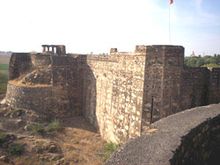The doctrine of lapsation was a policy of annexation initiated by the East India Company in the Indian subcontinent for the princely states, and applied until the year 1858, the year after Company rule was succeeded by the British Raj under the British Crown.
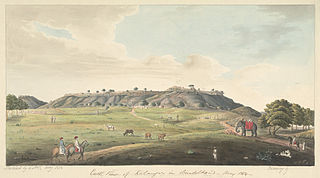
Banda is a city and a municipal board in Banda district in the state of Uttar Pradesh, India. Banda is divided among north, east, west and south Banda. Banda lies south of the Yamuna river in the Bundelkhand region. It is the administrative headquarters of Banda District. The town is well connected to major cities with railways and state highways. The town is near the right bank of the river Ken, 189 km south-west of Allahabad.

Sir George Jiwajirao Scindia KStJ was the ruler of the Gwalior state during the British Raj and later the Rajpramukh (Governor) of the Indian state of Madhya Bharat.

Mastani was the daughter of Chhatrasal and Ruhani Bai Begum. She was the second wife of the Maratha Peshwa Baji Rao I. Her relationship within the Maratha Brahmin family has been subject of both admiration and controversy and well adapted in Indian novels and cinema.

The Bundelkhand Agency was a political agency of the British Raj, managing the relations of the British government with the protected princely states of the Bundelkhand region.

Rampur State was a 15 gun-salute princely state of British India. It came into existence on 7 October 1774 as a result of a treaty with Oudh. Following independence in 1947, Rampur State and other princely states of the area, such as Benares and Tehri Garhwal were merged into the United Provinces. Rampur state had its capital in Rampur city and its total area was 945 sq miles. Rampur state was founded by Ali Mohammad Khan's younger son Faizullah Khan.

Dhami was a Princely State situated 26 kilometres (16 mi) west of Shimla, India. Its capital was Halog and the state formed a part of the region known as the Punjab Hill States Agency during the British Raj period. In 1941 it had an area of 73 square kilometres (28 sq mi) and a population of 5,114 people. In 1948 Dhami was made a part of Himachal Pradesh.

The Kolhapur State was a Maratha princely state of India, under the Deccan Division of the Bombay Presidency, and later the Deccan States Agency. It was considered the most important of the Maratha principalities with the others being Baroda State, Gwalior State and Indore State. Its rulers, of the Bhonsle dynasty, were entitled to a 19-gun salute – thus Kolhapur was also known as a 19-gun state. The state flag was a swallow-tailed saffron pennant.
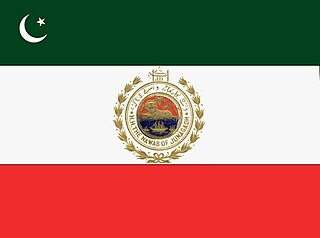
Junagarh or Junagadh was a princely state in Gujarat ruled by the Muslim Babi dynasty in India, which acceded to the Dominion of Pakistan after the Partition of British India. Subsequently, the Union of India annexed Junagadh in 1948, legitimized through a plebiscite held the same year.

The following list includes a brief about the titles of nobility or orders of chivalry used by the Marathas of India and by the Marathis/Konkanis in general.
Shamsher Bahadur I, was a ruler of the Maratha dominion of Banda in northern India. He was the son of Bajirao I and Mastani.

The Oudh State was a Mughal subah, then an independent kingdom, and lastly a princely state in the Awadh region of North India until its annexation by the British in 1856. The name Oudh, now obsolete, was once the anglicized name of the state, also written historically as Oudhe.
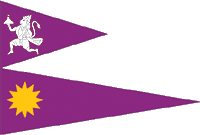
Ajaigarh State was one of the princely states of India during the period of the British Raj. The state was ruled by Bundela clan of Rajput But later on this place was ruled by Yadav (Dauwa) kings.. The state was founded in 1765 by Guman Singh and its capital was located in Ajaigarh, Madhya Pradesh. Sawai Maharaja Punya Pratap Singh signed the accession to the Indian Union on 1 January 1950.

Udaipur State was one of the princely states of India during the British Raj. The town of Dharamjaigarh was the former state's capital.

Bijawar State was a princely state of colonial India, located in modern Chhatarpur district of Madhya Pradesh.
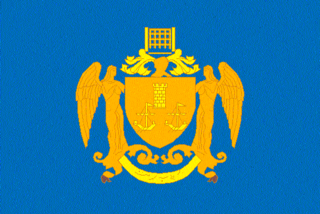
Khambhat state or Cambay state was a princely state in India during the British Raj. The city of Khambhat in present-day Gujarat was its capital. The state was bounded in the north by the Kaira district (Kheda) and in the south by the Gulf of Khambhat.

Ali Bahadur (1758–1802), also known as Krishna Sinha, was a Nawab of the dominion of Banda in northern India, a vassal of the Maratha Empire. He was the son of Shamsher Bahadur I and the grandson of Peshwa Bajirao I.
The Bhatt Peshwa family earlier known as Bhat family is a prominent Indian Chitpavan Brahmin family who dominated India for around 100 years in the late 18th century and early 19th century. Most of the members in this family were the Peshwas in the Peshwa Era of the Maratha Empire, and Peshwa later became their family name. During their regime, most of the Indian subcontinent was under their control. The last Peshwa, Baji Rao II, was defeated by the British East India Company in the Third Anglo-Maratha War in 1818. The territory was annexed to the British East India Company's Bombay Presidency, and he was pensioned.
Ali Bahadur II (1832–1873) was the last ruler (Nawab) of Banda. He decided to join the Indian Rebellion of 1857, he joined forces of Rani of Jhansi, Rao Sahib and Tantia Tope and was one of Major Commanders of Rebel force at Gwalior and in the aftermath his state was annexed by the British Raj. He also helped tatya tope in Siege of Charkhari. He surrendered in November 1858 and lived in exile at Indore with Pension of Rs. 36,000 per annum and he died in 1873. He was a descendant of Peshwa Baji Rao I and his Muslim wife Mastani.
